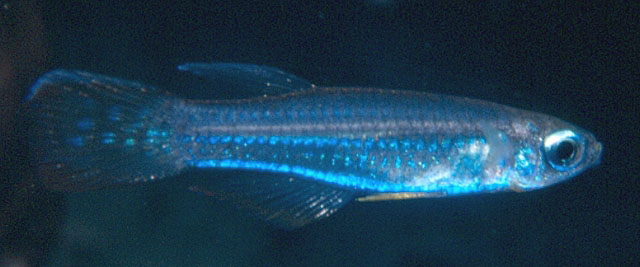| Procatopodidae (African lampeyes), subfamily: Procatopodinae |
| 4 cm TL (male/unsexed) |
|
benthopelagic; freshwater; pH range: 6 - 8; dH range: 5 - 12, non-migratory |
| Africa: coastal plains of southern Togo, southern Benin and southern Nigeria (Ref. 57259, 81647); also coastal plains of western and southwestern Cameroon (Ref. 81647). |
|
Dorsal spines (total): 0-0; Dorsal soft rays (total): 6-9; Anal spines: 0-0; Anal soft rays: 10-13. Diagnosis: Small ‘Lampeye’ species with relatively long fins; dorsal and anal fins pointed, caudal fin truncated; adult males with long ventral fins that may reach to the 5th or 6th anal fin ray; dorsal fin with 6-9 rays, anal fin with 10-13 rays; displacement between the dorsal and anal fins 1/7-9; scales on mid-longitudinal series 26-29 (Ref. 57259).
Colouration: Male colouration: translucent grey to pale olive overall colour with two longitudinal lines, consisting of large, light blue, blue-green or green iridescent spots, on the lower half of the body; upper line just below mid-body, lower line parallel to the lower body profile; a third, shorter line of iridescent spots may be present between the two prominent lines; dorsal and anal fins are pale olive to yellow, occasionally with an irregular pattern of red or white spots; the margins of these fins are usually marked by an intensification of the fin colour, although a white or orange-red margin may also be present; the pattern of the caudal fin varies on population level and is yellow to pale olive with light blue iridescent spots; an irregular pattern of yellow, orange or red spots is usually present on the caudal fin and the margin may be white, yellow or orange-red (Ref. 57259). Female colouration: translucent grey to pale olive with some light blue iridescent spots on the sides arranged in horizontal lines; the scales on the back and upper parts of the sides usually have narrow brown margins; all fins are colourless (Ref. 57259). Both sexes have a strongly reflective light blue spot in the upper part of the eye iris (Ref. 57259). |
| Found in small rivers and brooks in the swampy primary and secondary rainforest on the coastal plains (Ref. 3788, 57259). It feeds on worms, crustaceans and insects (Ref. 7020). It is not a seasonal killifish and very difficult to maintain in aquarium (Ref. 27139). |
|
Least Concern (LC); Date assessed: 07 June 2019 Ref. (130435)
|
| harmless |
Source and more info: www.fishbase.org. For personal, classroom, and other internal use only. Not for publication.
